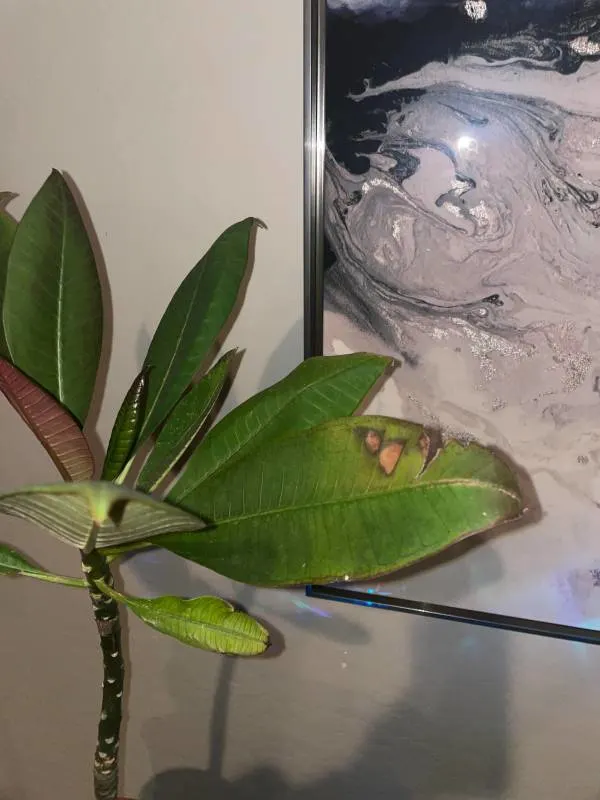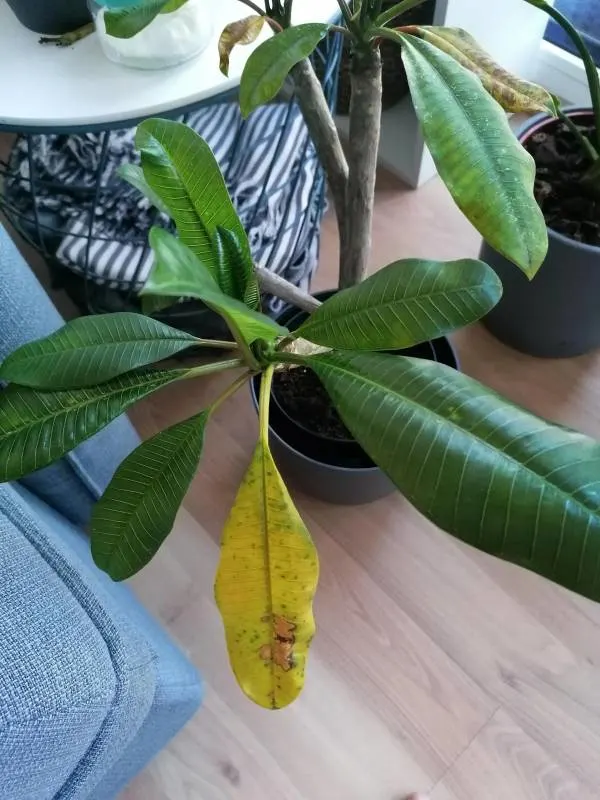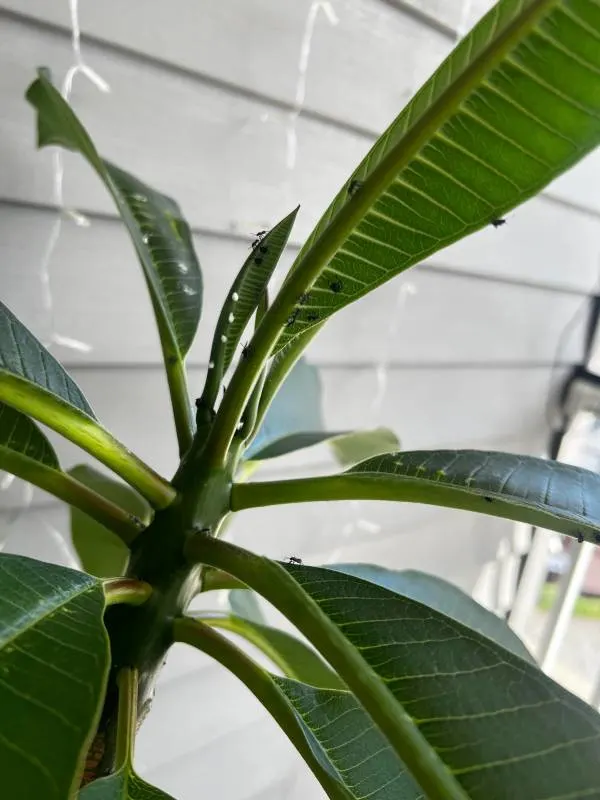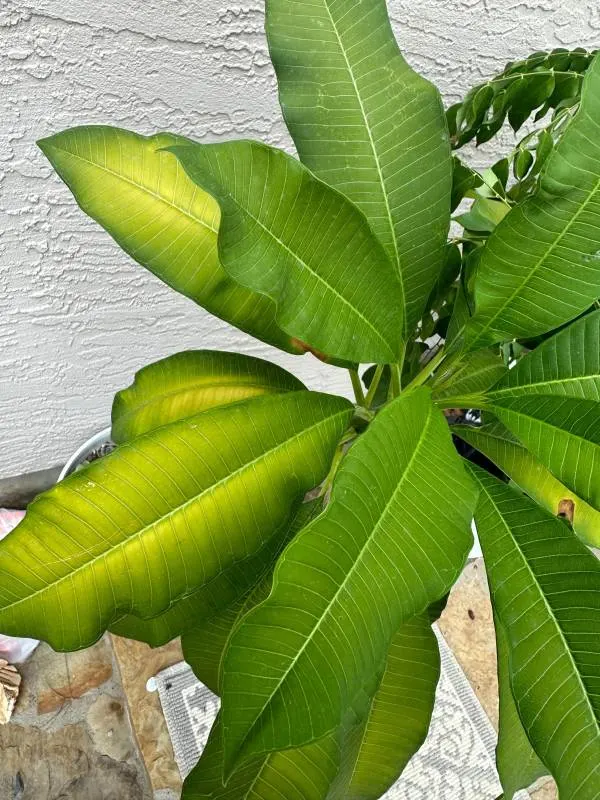Plumeria, affectionately known as Frangipani, originates from the tropical regions and has become a popular houseplant.
Usually, it is grown for its beautiful, colorful blooms and vibrant fragrance!
Because of its aesthetic appeal and fragrant flowers, Plumeria is an excellent choice for bouquets and floral gifts.
The interesting fact is that it is easy to take care of and can tolerate neglect to some extent. But despite its hardness, Plumeria plants can sometimes encounter the occasional problem of leaf curl.
While having curly leaves isn’t a big issue, it indicates that your Plumeria demands some attention.
So, without further ado, let’s begin!
- Why Are My Plumeria Leaves Curling?
- 1. Underwatering Can Cause Curling Leaves in Plumeria Plants
- 2. Overwatering Can Also Be the Reason for Plumeria Leaves Curling
- 3. Nutrient Deficiencies Can Cause Plumeria Leaves to Curl
- 4. Different Pests Can Cause Plumeria Leaves to Curl
- 5. Plumeria Leaves Can Also Curl Because of the Temperature Stress
- Conclusion!

Why Are My Plumeria Leaves Curling?
If you’ve noticed your Plumeria leaves curling, there could be various reasons behind it.
Therefore, it is better to understand the specific problem before trying to fix it. Before jumping into any decisions, remember to consider what your Plumeria needs.
Let’s break down the possible causes and solutions to help you with your problem!
1. Underwatering Can Cause Curling Leaves in Plumeria Plants
Plumeria plants need enough light and a good amount of water to stay happy.
If they don’t get enough water, their leaves start wilting and might even curl up—a signal that the plant is really thirsty.
Also, if the leaves are turning brown, it’s probably a sign that your Plumeria needs a good drink.
Checking the soil with your fingers is a handy way to know when it’s time to water your plant.
While curling leaves help Plumeria survive periods of drought and shade, they harm the plant’s overall appearance.
Also, if Plumeria leaves are repeatedly exposed to drought or environmental stress, they will become increasingly susceptible to leaf curling and may eventually die.
How to Fix an Underwatered Plumeria?
When you notice the signs of drought in your Plumeria plant, like dry soil or curling leaves, don’t panic.
Here is what you should do instead:
Stick your finger in the soil to check if the soil is dry. If it feels dry, your plant is dying from thirst.
Give your plant a good drink—slowly and thoroughly water your Plumeria until you see water coming out of the bottom drainage holes. When it’s hot, water it more often—2 to 3 times a week and make a schedule to water it regularly.
Put some mulch around your plant. It keeps the soil moist. Remove the mulch afterward if you feel that your plant doesn’t need it.
If the leaves are already curled, spray them with water to help them uncurl.
Water your plant every 7–10 days, and more often if it’s really hot.
These steps should make it easier to take care of your Plumeria plant.
2. Overwatering Can Also Be the Reason for Plumeria Leaves Curling
Apart from the underwatering, the leaves of the Plumeria plants also start curling when they are overwatered.
If you’re giving them lots of water every time, they will start looking yellow—that’s a sign you’re giving them too much to drink. If you keep drowning them, the leaves will start drooping, and such leaves start turning brown over time.
Also, when Plumeria plants get too much water, the roots might rot due to waterlogging. Afterwards, the roots of your Plumeria plant won’t be able to absorb water and nutrients properly from the soil. However, the water will continue to evaporate through transpiration loss.
It causes the plant leaves to curl to prevent further water loss.
Therefore, always make sure that the soil is never soggy. Water your Plumeria after every two weeks, but make sure that the soil isn’t always wet.
Pro Tip: In winter, Plumeria plants don’t need as much water, so it’s okay to be a little stingy. But in the spring, you can start watering them again.

How to Fix an Overwatered Plumeria?
If your Plumeria plant is getting too much water, it could lead to problems like fungus and root issues.
Here’s what you can do to fix it:
If you see signs of overwatering, stop watering your Plumeria right away.
If your Plumeria is in the ground and has mulch around it, take it away.
See if the pot has holes for water to drain out. Make sure the water drains well—a proper potting mix will help you with soil drainage.
Put fungicides in the soil to stop fungal infections in the roots.
If the rot hasn’t spread a lot, replant in healthy soil. If it’s too much, save the plant by growing new ones from the healthy parts.
To fix an overwatered Plumeria, let the soil dry completely. Then, slowly start watering again, making sure not to overdo it.
3. Nutrient Deficiencies Can Cause Plumeria Leaves to Curl
Like other tropical plants, Plumeria also rely on vital nutrients to stay healthy.
One essential nutrient they love is nitrogen.
It is a particular ingredient that helps them produce chlorophyll, which is critical for the process of photosynthesis.
An insufficient amount of nitrogen results in:
Curling leaves
Stunted growth
It can be caused when these plants do not get enough nitrogen either because the soil doesn’t have much or their roots can’t absorb it well.

How to Fix Plumeria with Nutrient Deficiencies?
If your Plumeria plant looks unhappy because it’s not getting enough essential nutrients, you can help it by using a special plant food.
Think about giving your plant a nutritious meal!
You can use a balanced fertilizer or one high in nitrogen every two to four weeks during the growing season.
Also, you can make your plant extra happy by adding fresh organic stuff, like plant-friendly snacks.
Just be careful not to give it too much fertilizer as it can cause different problems.
So, it’s best to find the right balance.
4. Different Pests Can Cause Plumeria Leaves to Curl
Plumeria leaves curl when there’s a severe infestation of sap-sucking insects.
Aphids, Mealybugs, and Spider mites are the common insect pests of Plumeria.
Let’s discuss all of them separately:

A) Aphids on Plumeria
Aphids come in different colors and are tiny insects that can harm the leaves of Plumeria plants, making them wilt.
Ants carry these aphids to the plants because they get a sweet liquid called Honeydew in return.
With their feeding habits, aphids can make yellow spots on the leaves, and the Honeydew they produce can attract a fungus called ‘Sooty mold.’
These bugs hide in curled leaves and can multiply really fast, so it’s essential to act quickly when you see even just one.
Hanging yellow, sticky cards around your Plumeria can help you spot them early.
B) Mealybugs on Plumeria
Mealybugs are tiny, white bugs that look like fluffy cotton and are often found on Plumeria plants.
They suck plant’s sap from the leaves and shoots, causing damage to the plant.
These pests multiply quickly and can create yellow spots on the leaves, making the plant look sick.
Mealybugs also leave behind a sticky substance called Honeydew, attracting ants to the infected Plumeria.
So, if you notice white, cotton-like bugs on your plant, take action to protect it from these sneaky invaders.
C) Spider mites on Plumeria
Spider mites are also a common bug that bothers Plumeria plants. You can find them on the stems and underneath the leaves.
If you see tiny webs around your Plumeria, that means there are spider mites.
These webs are usually on stems, leaves, flowers, and buds.
These bugs are hard to see because they are tiny, so it’s essential to act quickly when you notice the webs around your Plumeria.
If there are just a few mites, they might not harm your plant much.
But if there are a lot of them, they can stop your Plumeria from growing well or even make it die.
How to Control Pests on Plumeria?
To keep your Plumeria happy and bug-free, try these easy tricks.
If you spot tiny troublemakers like Aphids, Mealybugs, or Spider mites, give your plant a good shower with a garden hose to wash them away.
Prune off the branches that are infected by these sap-sucking bugs.
For a hands-on approach, grab a cotton swab dipped in rubbing alcohol and gently wipe off the insects.
Once the pests have been removed, the Plumeria curled leaves can be fixed by applying a diluted solution of Neem oil or insecticidal soap to the affected area.
Regularly inspect your plant for signs of pests or diseases, catching issues early on before they become significant problems.
5. Plumeria Leaves Can Also Curl Because of the Temperature Stress
Plumeria leaves curl up when they get temperature stress.
This can happen because of intense sunlight, high temperatures, low humidity, and drought conditions.
Getting my point?
When it gets too hot, the cells in the leaves start to break down, making them lose water and become dry and brittle.
As they lose water, they also curl and twist.
In serious cases, the infected leaves can turn brown and fall off.
Plumeria plants can usually be heat-tolerant, but if it’s too extreme for too long, it can hurt them.
The first thing you should do is to check the temperature of your surroundings. It is because, on warm days, plants curl up to protect themselves from too much sunlight and to maintain their moisture.
They do this by sending water back down to their stems and roots, which causes the leaves to curl.

How Can You Fix Plumeria with Temperature Stress
If your Plumeria seems unhappy because of the excessive heat, there are easy things you can do to help it feel better:
Give it enough water. Plumeria likes damp soil, so water it regularly and spray the leaves if needed.
Plumeria likes high humidity, so spray water on the leaves or put the pot on a tray of pebbles with water. However, stay careful because water droplets on the leaves can magnify the rays coming from the sun, and can result in a sun burn. So, it’s better to give your plant a light mist after the sun sets down.
Don’t give it too much fertilizer, as excess fertilizer can stress the plant, especially in the heat.
Plumerias prefer temperatures between 65–80°F (18–27°C), so check with a thermometer.
Protect it from extreme weather. If it’s too hot or cold, move it inside or to a shady spot.
It’s simple, and these tips can help your Plumeria feel better and avoid problems.
Conclusion!
If your Plumeria leaves are curling, it’s an alarming signal given by your plant.
Check if it’s thirsty or drowning, find the right balance of sunlight, and watch out for tiny troublemakers like Aphids, Mealybugs, and Spider mites.
If it’s stressed from moving or exposed to harmful chemicals, give it some extra love and care.
Your Plumeria just needs a little attention to unfold its vibrant beauty.
So, go on, and let your Frangipani thrive with simple, thoughtful care!
Best Regards,
Moiz Atiq.
